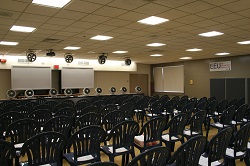The EEU at a glance.
At first glance, the Environmental Exposure Unit (EEU) is simply a room with a large seating area. In fact, this well-controlled environment is one of the best places in the world to test the effectiveness of allergy medications.
best places in the world to test the effectiveness of allergy medications.
The key is a unique combination of technology and process. Outside air is brought in and purified to remove dusts and other contaminants. Allergens such as ragweed pollen are released into the room through a feeder while state-of-the-art electronics control concentration and dispersion rate. Researchers regularly check the pollen levels to ensure that they are consistent throughout the room and that all participants are equally exposed. Participants record any symptoms they have.
The atmosphere in the EEU is friendly and relaxed. Participants watch movies, listen to the radio, do homework, talk with other participants and enjoy good meals and snacks. “From our allergy study participants’ point of view, being in the EEU feels just like the outdoors during pollen season,” says Terry Walker, Director of Clinical Operations. “But from a scientist’s point of view, it’s even better. The unit simulates natural outdoor pollen conditions with none of the unpredictable weather factors that can interfere with the evaluation of medications.”
In an outdoor environment, the level of pollen in the air varies widely, making it difficult to know just how much pollen people have been exposed to. Pollen levels are influenced by many factors: speed and direction of the wind, humidity and rain. Also, the amount of allergy-causing potential of pollen varies widely from year to year.
By controlling these physical factors, the EEU system enables research trials to be consistent. Research participants also contribute significantly to the reliability of EEU results. EEU researchers have shown that people can detect subtle differences in their responses to different medications and doses.
When EEU studies are repeated, the results are similar – even when trials are conducted in different seasons and years apart. This means that conclusions drawn from EEU research are highly reliable and can be applied in medical practice.
Says Dr. Ellis: “The EEU’s capacity for reproducibility of results is unique, providing clear evidence of efficacy of treatment when it exists.”
In addition to helping to develop better treatments, EEU research has enhanced understanding of the mechanics of allergy. The EEU team has learned that some people react more quickly than others and that reactivity in individuals can change significantly over time. The team applies their growing understanding of the mechanics of allergy with the EEU to “awaken” allergic responses through controlled exposures to allergens before research trials. Known as “priming”, these prior exposures ensure that participants are reactive outside of the natural ragweed season. This enables EEU studies to be conducted throughout the year.


